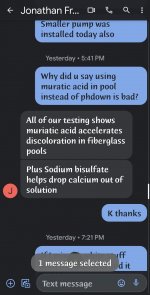- Jul 21, 2020
- 159
- Pool Size
- 7000
- Surface
- Fiberglass
- Chlorine
- Salt Water Generator
- SWG Type
- Jandy Truclear / Ei
Pump, sand filter, heat pump, salt cell then back to returns. That's all the equipment that is back there.No sir
Pump, sand filter, heat pump, salt cell then back to returns. That's all the equipment that is back there.No sir
I doubt that anyone says that.
Ask them, in writing, to clarify their position on that.
Someone misspoke or you misunderstood.
In any case, get a liter of distilled water and add 200 milligrams of the precipitate to the water.
Allow the precipitate to dissolve and then test the water for TA and calcium.

Ok I'm gonna try to do that. I will say over past 12 hours less is gathering on the flat surfaces. So I'm gonna let it build up a bit and see if I can get that much.They do not say that muriatic acid drops calcium out of suspension.
The person says that sodium bisulfate helps drop calcium out of suspension.
The person is incorrect unless you add enough sulfate to create calcium sulfate.
So, the statement is not 100% wrong, but it is it bad advice if they are trying to increase your sulfates high enough that calcium sulfate begins to precipitate.
In any case, if you do the test with distilled water and 200 milligrams of the precipitate, the TA and calcium hardness should be about 200 ppm when you test the water if the precipitate is calcium carbonate.

What attracts and allows calcium to attach to it?say that it's an ionization issue with the cobalt blue color. That it attracts and allows calcium to attach to it very easily because of the ionization of the cobalt and the calcium.
I believe what he was saying.....maybe ionization is wrong term....that the cobalt has a negative charge and the calcium is a positive charge therefore the calcium gets attached to the sides of the wall easily. Once again really, at this point, just trying figure out the white stuff on bottom of pool and from keeping it from coming back.Is the pool manufacturer trying to get your calcium to precipitate?
Fiberglass pools have had chalking and discoloration issues for decades.
A handful of people at the manufacturer might know the real reason why the discoloration happens, but most people do not.
They don't want anyone to know everything that they know including most of the employees at the company.
They intentionally create a lot of confusion by throwing out a lot of misinformation about what the cause is.
They have blamed everything from liquid chlorine to sunspots.
Their claim that they have evidence that muriatic acid causes discoloration is complete nonsense.
If the acid is directly applied to the surface, then you can have problems.
For example, if you add acid using the "Slug" method, it will cause problems.
Properly applied, muriatic acid causes zero problems.
My scale only measures in whole grams. 1 gram is as low as it will go. Can I just do 1 gram and test ta and ch?I doubt that anyone says that.
Ask them, in writing, to clarify their position on that.
Someone misspoke or you misunderstood.
In any case, get a liter of distilled water and add 200 milligrams of the precipitate to the water.
Allow the precipitate to dissolve and then test the water for TA and calcium.

